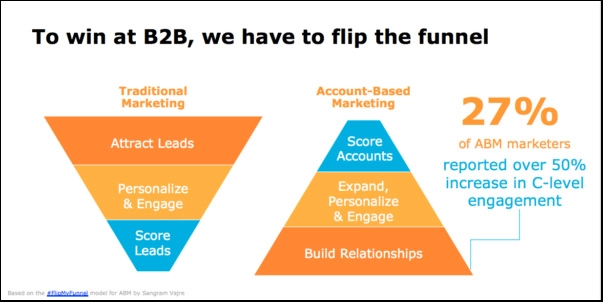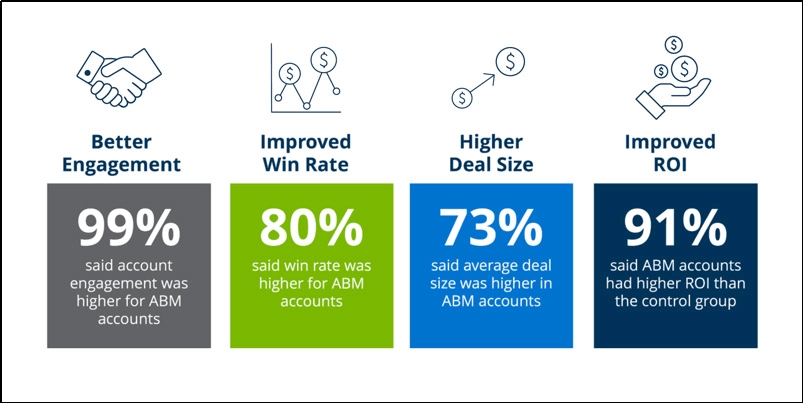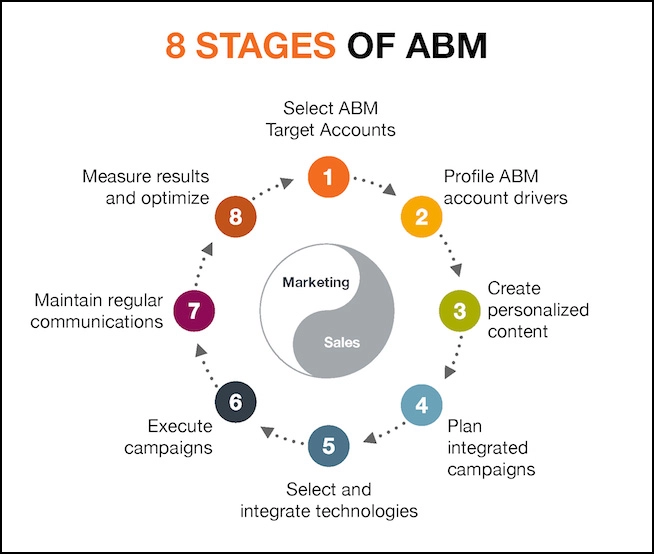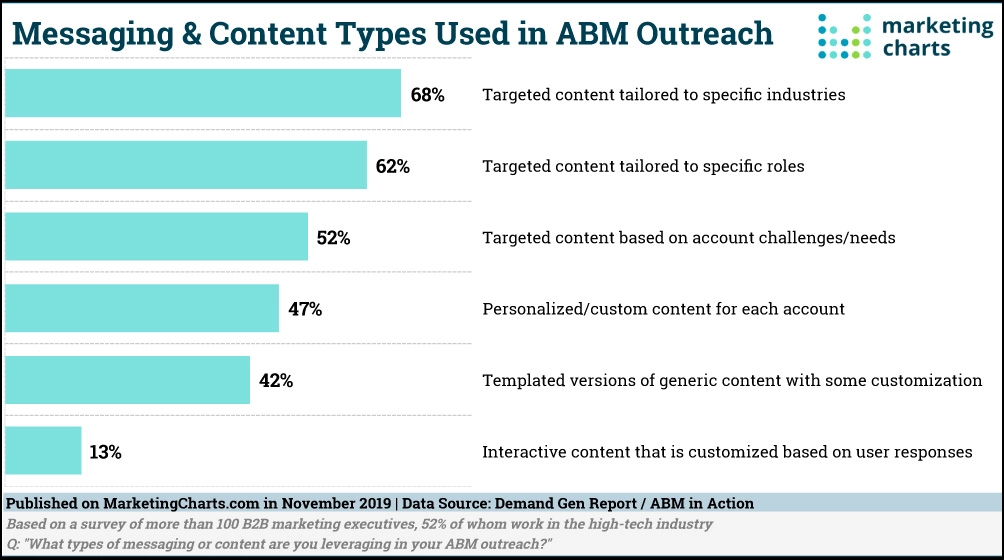
Introduction
Deal closure lies squarely with the sales reps. However, it is a culmination of the efforts that boh sales and marketing teams put in the selling process. Statistics show that companies that have aligned their sales and marketing functions well perform close 67% more deals than those that don’t.
It is no wonder that successful sales teams are increasingly engaging in Account-Based Marketing (ABM) – which represents a shift from targeting leads, to narrowing focus on the most valuable accounts a company has. In ABM, the collaboration between sales and marketing teams is largely focused on improving the quality of leads, assigning prospects and accounts, and increasing the velocity of the sales pipeline.
The ABM-Sales Factor Link
ABM is a marketing strategy that involves targeting specific accounts that are a good fit for a company’s product or service offerings and offer the highest returns. The strategy also involves personalizing interactions with each account as companies focusing on nurturing mutually beneficial, long-lasting relationships with prospects.

Essentially, ABM works well when sales and marketing teams are fully involved. The sales team shares information from the conversations they have with prospects and the data they gather from researching targeted accounts. Such information often includes the
pain points that prospects have, what they are interested in and the decision making roles in the company.
The outcomes of utilizing this information are incredible. Available statistics show B2B companies that use this information to inform their ABM strategy can generate up to 200% more revenue compared to those that don’t. On the hand hand, marketing teams complement the outreach efforts of sales teams by generating personalized content like infographics, case studies, guides, and blog posts. This strong collaboration between sales and marketing teams can help B2B companies to enhance content accuracy, improve lead quality and boost lead-to-sale conversion speeds.
Successful B2B sales teams engage in ABM for one main reason – high sales win rates. Statistics show that companies that allow sales teams to participate in ABM experience up to 38% more win rates in sales and register higher customer retention rates. Other benefits of ABM are better customer engagement, higher deal size and improved return on investment.

By and large, ABM helps marketers to meet the needs of sales teams. However, sales teams must establish their key prerequisites with marketing teams by:
- Sharing a list of accounts they wish to target: To do this, they review existing customers to see how valuable those accounts are to the business. They also analyze key information about their targets including their interests and pain points.
- Providing basic information about target personas: This is critical in providing marketing teams with the details they need to develop personas. The personas will determine the content they’ll need to implement a content marketing strategy. Most importantly, marketing teams can use the insights that sales teams gather from their research and direct conversations they have with prospects to customize content and make it more appealing to target accounts. This generates positive results because 95% of B2B buyersopt to buy from providers that make meaningful content that empowers them in every stage of their purchase journey available.
- Informing lead matching process: Sales teams can help companies to address the challenge of lead-to-account matching that 44% of marketers consider their biggest challenge in implementing an ABM strategy. They do this by helping marketing teams to develop criteria for routing leads to accounts immediately they get into the company’s customer relationship management or marketing automation system.
How ABM Can Boost B2B Deal Closures
As a marketing strategy, ABM allows B2B companies to focus on cultivating high value relationships with a smaller audience rather than a wide audience. This means targeting prospects with offers and content that are most relevant to their needs. To do this, B2B companies create an account for individual prospects, then treat each account as an individual market with its own marketing message. See the different stages involved in ABM in the image below:

Here are five ways ABM plays a role in boosting B2B deal closures:
1. Identifying High Potential Accounts
When you decide to apply the ABM marketing strategy, you start by creating a list of accounts that have the highest potential of becoming customers. The number of accounts you list is determined by your company’s ability to serve them. The easiest way to identify the most valuable prospects is through the use of a lead-scoring technology. Essentially, the potential of an account should be determined by its propensity to close deals.
B2B sales and marketing teams can develop a criteria for determining this by looking at the attributes that other accounts that already closed deals with the company have. Some common attributes that most high value accounts feature include high traffic sites, high social media activity and the use of multiple marketing platforms.
2. Conducting Targeted Marketing
After identifying ABM accounts, it’s time to initiate targeted communication. The content for this communication is highly customized for each account. Ideally, content for targeted communication should help your ABM accounts to navigate the purchase process. It also needs to be relevant to the decision makers – who can be as many as 10 – who are involved in the B2B purchase journey.

To communicate to ABM accounts effectively, you’ll need to personalize your content and ensure that it covers all decision-maker touch-points. Here are some useful tips to help you achieve this:
- Familiarize yourself with the personas of key decision makers
- Gather insights about key decision makers including the content formats they prefer
- Develop a content plan that customizes information that decision makers need in each stage of the buyer journey
- Personalize your content to make it relevant to your ABM accounts. You can do this by adding targeted titles, industry specific images, case studies that are market specific, targeted emails or landing pages or customized intros
- Disseminate the content to your target audience. You can do this through content syndicationby publishing gated content on leading sites that your audience frequent or deliver it to ABM accounts via email.
- Measure effectiveness of ABM content either by running A/B tests or using SEO
3. Reinforcing Sales Messages
Traditionally, marketers quit engaging prospects once they’ve turned leads into opportunities, leaving the sales teams to close the deal. But this is not the case with ABM. In this strategy, sales and marketing teams continue collaborating until the sales cycle has been closed. In this scenario, sales do not happen in a vacuum. Marketing teams continue to work in the background – driving brand awareness while reinforcing the messages that sales reps send during their interactions with target accounts.
As sales teams engage decision makers in such accounts, ABM can enhance B2B content syndication by utilizing multi-channel touches across email, displayed ads, direct mail and emails. Some of the content that ABM can help disseminate include:
- Case studies
- White papers
- Product updates
- Webinars
- eBooks
- Competitive analyses
4. Running Account-Based Adverts
ABM can help sales reps to reach key decision makers whenever they experience challenges. B2B companies can easily do this by implementing display ads that target specific roles to reach such decision makers in targeted accounts. They can also implement department-specific ads to reach a bigger audience or create awareness about the value their solutions offer. Creating dynamic adverts can go a long way in nurturing target opportunities across different sales cycle stages. For instance, if an account converts into opportunities, B2B marketers can shift them to the acceleration stage automatically.
5. Supporting Sales Teams With Marketing Campaigns
ABM can play an important role in supporting the efforts of sales teams to provide decision makers in target accounts with experiences, education and evidence that is well aligned with the buyer’s journey. Engaging open opportunities is not the same as engaging leads. With open opportunities, B2B marketing teams have in depth knowledge of their targets.
As such, sales and marketing teams can focus their energies on identifying the experiences and content their ABM accounts would find most valuable. That data and insights should guide their marketing efforts and support their sales teams to push ABM accounts down the sales funnel. Some actions that both teams can take to boost deal closure include:
- Conducting direct mail campaigns
- Running ad campaigns on specific products highlighting the pain points they solve
- Sharing testimonials on how existing customers are using the product to solve similar challenges
- Sending content or landing pages designed for specific accounts
Final Thoughts
As a marketing strategy, ABM allows you to cultivate high value relationships with accounts that are a good fit for a company’s product or service offerings and offer the highest returns. A well executed ABM strategy can go a long way in boosting the number of deals that your sales team closes and increase your return on investment significantly. If your company is using the ABM strategy, implementing the five strategies can go a long way in providing the sales teams to close more deals and increase your sales revenue significantly.
Our blog
Latest blog posts
Tool and strategies modern teams need to help their companies grow.

B2B companies must generate leads that are ready to buy their products in order to me...

In the absence of a constant flow of leads, sales teams can't meet their targets and ...

Podcasts and webinars are powerful tools that marketers can use to reach new audience...



